Biology > GCSE MARK SCHEME > GCE Biology B H422/02: Scientific literacy in biology Advanced GCE Mark Scheme for Autumn 2021 (All)
GCE Biology B H422/02: Scientific literacy in biology Advanced GCE Mark Scheme for Autumn 2021
Document Content and Description Below
GCE Biology B H422/02: Scientific literacy in biology Advanced GCE Mark Scheme for Autumn 2021 Oxford Cambridge and RSA Examinations GCE Biology B H422/02: Scientific literacy in biology Advanced... GCE Mark Scheme for Autumn 2021Oxford Cambridge and RSA Examinations OCR (Oxford Cambridge and RSA) is a leading UK awarding body, providing a wide range of qualifications to meet the needs of candidates of all ages and abilities. OCR qualifications include AS/A Levels, Diplomas, GCSEs, Cambridge Nationals, Cambridge Technicals, Functional Skills, Key Skills, Entry Level qualifications, NVQs and vocational qualifications in areas such as IT, business, languages, teaching/training, administration and secretarial skills. It is also responsible for developing new specifications to meet national requirements and the needs of students and teachers. OCR is a not-for-profit organisation; any surplus made is invested back into the establishment to help towards the development of qualifications and support, which keep pace with the changing needs of today’s society. This mark scheme is published as an aid to teachers and students, to indicate the requirements of the examination. It shows the basis on which marks were awarded by examiners. It does not indicate the details of the discussions which took place at an examiners’ meeting before marking commenced. All examiners are instructed that alternative correct answers and unexpected approaches in candidates’ scripts must be given marks that fairly reflect the relevant knowledge and skills demonstrated. Mark schemes should be read in conjunction with the published question papers and the report on the examination. © OCR 2021H422/02 Mark Scheme October 2021 Annotations Annotation Meaning DO NOT ALLOW Answers which are not worthy of credit IGNORE Statements which are irrelevant ALLOW Answers that can be accepted ( ) Words which are not essential to gain credit __ Underlined words must be present in answer to score a mark ECF Error carried forward AW Alternative wording ORA Or reverse argumentH422/02 Mark Scheme October 2021H422/02 Mark Scheme October 2021 Question Answer Mark AO element Guidance 1 (a) (i) virus enters (host) cell viral , DNA / RNA / genetic material , replicates viral proteins made using cell’s mechanisms max 2 1.1 1.1 1.1 ALLOW takes over host cell metabolism 1 (a) (ii) (because it was) not present in the (wild) population (because it was) only present in test sites was not present in the population at a baseline level max 1 2.1 2.1 1 (a) (iii) (because there was a) sudden increase in incidence 1 2.1 1 (b) HIV MYXV genetic material is RNA virus particle contains reverse transcriptase virus has a capsid 3 2 x 1.1 1 x 2.1H422/02 Mark Scheme October 2021 Question Answer Mark AO element Guidance 1 (c) steep / AW , decrease from 1950 to 1955 and gradual / AW , increase to 1990 use of two pieces of correct data from graph e.g. 85% in 1950 / 35% in 1955 / 60% in 1990 2 2.1 2.1 1 (d) (i) (surviving rabbits produce) memory (T/B) cells alleles for resistance (to MYXV) would be selected for (so the) allele frequency increases (in the population) max 2 2.2 2.2 2.2 ALLOW advantageous allele(s) passed on 1 (d) (ii) (vaccination involves) giving pathogen antigens (formation of) memory (T/B) cells exposure to pathogen leads to secondary immune response (which) destroys / kills , pathogen before it can cause , disease / death max 3 1.2 1.2 1.2 1.2 ALLOW any correct example of vaccine, e.g. live-attenuated, subunit vaccines, pathogen fragments ALLOW rapid production of antibodies 1 (d) (iii) vaccinated hosts can still transmit virus (so) unvaccinated , birds / flocks, could become infected OR (high) mutation rate leads to antigen variability so antibodies produced by vaccination no longer specific 2 2.5 2.5 2.5 2.5H422/02 Mark Scheme October 2021 Question Answer Mark AO element Guidance 1 (d) (iv) for susceptible birds would die before they could infect other birds resistant birds (are more likely to) encourage evolution of more virulent pathogens against (but) evolution of virulence may not matter for resistant birds hypervirulent pathogens could threaten , non-resistant / non-GMO , flocks ethical issues if industrial practices threaten organic producers susceptible birds may also be susceptible to , related / similar , pathogens max 4 3.2 3.2 3.2 3.2 3.2 3.2 ALLOW other unambiguous term for birds throughoutH422/02 Mark Scheme October 2021 Question Answer Mark AO element Guidance 2 (a) (i) (use) endoscopy / colonoscopy (to obtain a) biopsy sample observe cancerous cells in sample OR take a blood sample use flow cytometry with (monoclonal) antibodies to colorectal cancer (markers) max 2 2.5 2.5 2.5 2.5 2.5 ALLOW description of any valid method such as microscopy, histology, etc. 2 (a) (ii) (yes because) mortality rate is higher in the (FOBT) positive group (but there is) no evidence that this is linked to inflammation 2 3.2 3.2H422/02 Mark Scheme October 2021 Question Answer Mark AO element Guidance 2 (a) (iii) for (there is a) correlation between positive FOBT and risk of CRC the initial screening is non-invasive test can be done at home against (however, there is still) a need for confirmation by other means (there is a) risk of false , negatives / positives (there could be a) high cost many people may not want to do the test people may not attend follow-up screening max 4 3.2 3.2 3.2 3.2 3.2 3.2 3.2 3.2 ALLOW the test does not identify all cases of CRC / test may not be performed correctly.H422/02 Mark Scheme October 2021 Question Answer Mark AO element Guidance 2 (b) Please refer to the marking instructions on page 4 of this mark scheme for guidance on how to mark this question. In summary: Read through the whole answer. (Be prepared to recognise and credit unexpected approaches where they show relevance.) Using a ‘best-fit’ approach based on the science content of the answer, first decide which of the level descriptors, Level 1, Level 2 or Level 3, best describes the overall quality of the answer. Then, award the higher or lower mark within the level, according to the Communication Statement (shown in italics): o award the higher mark where the Communication Statement has been met. o award the lower mark where aspects of the Communication Statement have been missed. • The science content determines the level. • The Communication Statement determines the mark within a level. 2 (b) Level 3 (5–6 marks) Description, with examples, of the action of tumour suppressor genes and proto-oncogenes, with no/few errors or omissions. There is a well-developed line of reasoning which is clear and logically structured. The information presented is relevant and substantiated. Level 2 (3–4 marks) Description of the action of tumour suppressor genes and proto-oncogenes, with an example. There is a line of reasoning presented with some structure. The information presented is relevant and supported by some evidence. Level 1 (1–2 marks) Description of the action of tumour suppressor genes or proto-oncogenes. There is an attempt at a logical structure with a line of reasoning. The information is in the most part relevant. 0 marks No response or no response worthy of credit. 6 1.1 1.2 Indicative scientific content: Tumour suppressor genes • slow the rate of cell division • stimulate apoptosis of cells with damaged / faulty DNA Examples • TP53 protein / p53 gene • BRCA1/BRCA2 • refer to list / TL Proto-oncogenes mutate to become oncogenes • stimulate cell division • activate DNA replication • control production of growth factors, cyclins and CDKs Examples • Ras • c-MycH422/02 Mark Scheme October 2021 Question Answer Mark AO element Guidance 3 (a) Statement Letter(s) fMRI shows these areas of the brain to be active when playing a musical instrument A or F Temperature-sensitive neurones are located in this area of the brain C Traumatic injury to either of these areas can lead to overor under-production of sex hormones. C or D This region of the brain controls heart rate and breathing rate. E Stroke affecting part of this area of the brain could cause loss of control of muscles in the arms or legs. A 5 correct = 4 marks, 4 correct = 3 marks, 3 correct = 2 marks 2 correct = 1 mark 4 2.1 1.1 2.1 1.1 2.1 3 (b) (i) (use) tympanic / ear , method (because) eardrum shares its blood supply with the thermoregulatory centre 2 1.1H422/02 Mark Scheme October 2021 Question Answer Mark AO element Guidance 3 (b) (ii) Please refer to the marking instructions on page 4 of this mark scheme for guidance on how to mark this question. In summary: Read through the whole answer. (Be prepared to recognise and credit unexpected approaches where they show relevance.) Using a ‘best-fit’ approach based on the science content of the answer, first decide which of the level descriptors, Level 1, Level 2 or Level 3, best describes the overall quality of the answer. Then, award the higher or lower mark within the level, according to the Communication Statement (shown in italics): o award the higher mark where the Communication Statement has been met. o award the lower mark where aspects of the Communication Statement have been missed. • The science content determines the level. • The Communication Statement determines the mark within a level. Level 3 (5–6 marks) A detailed description of the processes leading to hypothermia and a description of appropriate treatments, with no/minor errors or omissions. There is a well-developed line of reasoning which is clear and logically structured. The information presented is relevant and substantiated. Level 2 (3–4 marks) A description of the processes leading to hypothermia, with some errors or omissions and a limited description of an appropriate treatment. OR a detailed description of the processes leading to hypothermia (treatment is missing). There is a line of reasoning presented with some structure. The information presented is relevant and supported by some evidence. Level 1 (1–2 marks) A description of the processes leading to hypothermia, with major errors or omissions or a description of an appropriate treatment. There is an attempt at a logical structure with a line of reasoning. The information is in the most part relevant. 6 2 x AO1.1 4 x AO1.2 Indicative scientific content: Processes • Hypothermia is lowering of body temperature outside normal range / below 35º C • Metabolic / enzyme reactions slow due to less kinetic energy. • So less metabolic heat is generated. • Positive feedback leads to body temperature falling further. Treatment Raise body temperature by: • Use of warm, dry blankets. • Move to a warm room. • Remove wet clothing. • Application of warm compresses to neck, groin and chest. • Warm, non-alcoholic drinks • Do not heat arms and legs as this forces cold blood back towards major organs. • Give expired air resuscitation if he stops breathing.H422/02 Mark Scheme October 2021 Question Answer Mark AO element Guidance 0 marks No response or no response worthy of credit. 3 (c) (i) seasonal trend: most cases of hypothermia in winter / most cases of hyperthermia in summer (because of) trends in seasonal temperatures incidence of hyperthermia is greater there is still some hypothermia in summer Max 3 2.2 2.2 2.2 2.2 ALLOW incidence of hypothermia is lower 3 (c) (ii) higher proportion of hypothermia patients required hospital admission (because) hypothermia is (usually) more life-threatening (because) hypothermia is more likely to affect , older / more vulnerable , patients max 2 2.2 2.2 2.2 ALLOW a response based on the suggestion that more hyperthermia patients die before they reach hospital 3 (c) (iii) increase in hyperthermia between 2004 and 2005 climate change / global heating , could increase incidence of hyperthermia no evidence about average (summer) temperatures only 2 years’ data is not enough to draw valid conclusion max 3 3.2 3.2 3.2 3.2 ALLOW increased reportingH422/02 Mark Scheme October 2021 Question Answer Mark AO element Guidance 4 (a) (i) use a colorimeter to measure concentration of product (description of) use of standard curve to convert absorbance to concentration measure rate of appearance of product / description of plotting graph and use of tangent repeat at different concentrations of substrate keep all other , conditions / named condition , constant max 3 2.7 2.7 2.7 2.7 2.7 4 (a) (ii) (so that) enzyme concentration is not a limiting factor 1 2.7 4 (a) (iii) FIRST CHECK ON ANSWER LINE If answer = 1.55 mol dm–3 award 2 marks Vmax = 9.8, so ½ Vmax = 4.9 value for KM in the range 1.50 – 1.60 (correct units =) mmol dm–3 2 2.8 2.8 4 (a) (iv) (because the) curve never reaches Vmax (because it is) difficult / impossible , to reach high enough [S] (so) Vmax / maximum rate , will never be achieved max 2 3.2 3.2 3.2 ALLOW idea of asymptotic curve ALLOW limited substrate solubilityH422/02 Mark Scheme October 2021 Question Answer Mark AO element Guidance 4 (b) (i) slope = 0.55 1 2.6 ALLOW answer in range 0.50 – 0.60 4 (b) (ii) slope = KM/Vmax 1 2.6 ALLOW ECF from candidate’s value for slope. ALLOW candidate’s numerical value for slope. 4 (b) (iii) FIRST CHECK ON ANSWER LINE If answer = 2.75 award 2 marks KM = slope × Vmax correct value for KM (units not required) 2 2.6 2.6 ALLOW ECF from candidate’s value for slope. MP2 does not require units as this has already been tested in MP2 of Q4(a)(iii)H422/02 Mark Scheme October 2021 Question Answer Mark AO element Guidance 5 (a) transcribed / expressed histones methylation gametes 4 1.1 1.1 1.1 1.1 ALLOW translated ALLOW (named) sex cells 5 (b) mutation is unlikely to , have occurred in many parents / affect all offspring (whereas) DNA methylation / acetylation of histones , could have occurred in , many / all , parents (exposed to hypoxia) (which) activates / inhibits , expression of genes related to resistance to hypoxia lack of oxygen is a selective pressure (but biochemical) evidence of epigenetics in offspring is needed max 3 3.2 3.2 3.2 3.2 3.2 5 (c) (i) prophase 1 ALLOW mitosis 5 (c) (ii) (reference to) reproductive isolation epigenetic changes alter gene expression stops , meiosis / gamete formation (because) hybrids are infertile (so) species would diverge / remain separate max 3 3.2 3.2 3.2 3.2 3.2H422/02 Mark Scheme October 2021 Question Answer Mark AO element Guidance 6 (a) (i) respirometer 1 1.2 6 (a) (ii) protein could be the respiratory substrate between 0 – 5 days / 10 – 25 days it is not the respiratory substrate at , start of germination / after 25 days RQ < 1.0 or >0.7(2) might be due to mixture of substrates max 2 3.2 3.2 3.2 6 (a) (iii) measure protein content at different times e.g. using Biuret test / test strips 2 3.3 3.3 6 (a) (iv) at time zero / start of germination , (named) carbohydrate was being respired between 5 and 10 days , fats / oils , are being respired from ~25 days onwards carbohydrate is being respired between 0 – 5 days / 10 – 25 days , a mixture of substrates are being respired max 3 3.2 3.2 3.2 3.2H422/02 Mark Scheme October 2021 Question Answer Mark AO element Guidance 6 (b) (i) FIRST CHECK ON ANSWER LINE If answer = 0.72 award 2 marks evidence of use of CO2/O2 (regardless of correct values) 18 / 25 = 0.72 2 2.2 2.2 Working: Balanced equation = C18H32O2 + 25O2 18CO2 + 16H2O calculation of RQ = 18 / 25 = 0.72 ALLOW ECF from incorrectly balanced equation 6 (b) (ii) RQ would increase because less oxygen would be used 2 2.1H422/02 Mark Scheme October 2021 Question Answer Mark AO element Guidance 7 (a) Example Act. Pass. Nat. Art. Snake antivenoms consist of sheep or horse antibodies to snake venom proteins. They are given to treat snake bite. A mixture of proteins purified from the Haemophilus influenzae virus is used to reduce the risk of a person getting the ‘flu. Following exposure to a pathogen, a person develops memory T and B cells. A calf receives antibodies from its mother in colostrum. 4 1.1 1 mark per correct rowH422/02 Mark Scheme October 2021 Question Answer Mark AO element Guidance 7 (b) (i) (Student’s) t-test (because they have) mean data / (are) testing the difference between means 2 2.8 2.8 7 (b) (ii) group I (because they had the) highest concentration of IgE / highest allergic response 2 2.7 2.7 7 (b) (iii) breastfeeding by mothers with AAD reduces degree of AAD in offspring something / antibodies , in breast milk must protect against allergic reactions (but) humans may not respond in the same way as mice results may only apply to allergic mothers passing on immunity to allergy max 3 2.7 2.7 2.7 2.7 ALLOW ‘allergic mothers’ for ‘mothers with AAD’OCR (Oxford Cambridge and RSA Examinations) The Triangle Building Shaftesbury Road Cambridge CB2 8EA OCR Customer Contact Centre Education and Learning Telephone: 01223 553998 Facsimile: 01223 552627 Email: general.qualifications@ocr.org.uk [Show More]
Last updated: 2 years ago
Preview 1 out of 21 pages

Buy this document to get the full access instantly
Instant Download Access after purchase
Buy NowInstant download
We Accept:

Reviews( 0 )
$5.00
Can't find what you want? Try our AI powered Search
Document information
Connected school, study & course
About the document
Uploaded On
Oct 07, 2022
Number of pages
21
Written in
Additional information
This document has been written for:
Uploaded
Oct 07, 2022
Downloads
0
Views
100

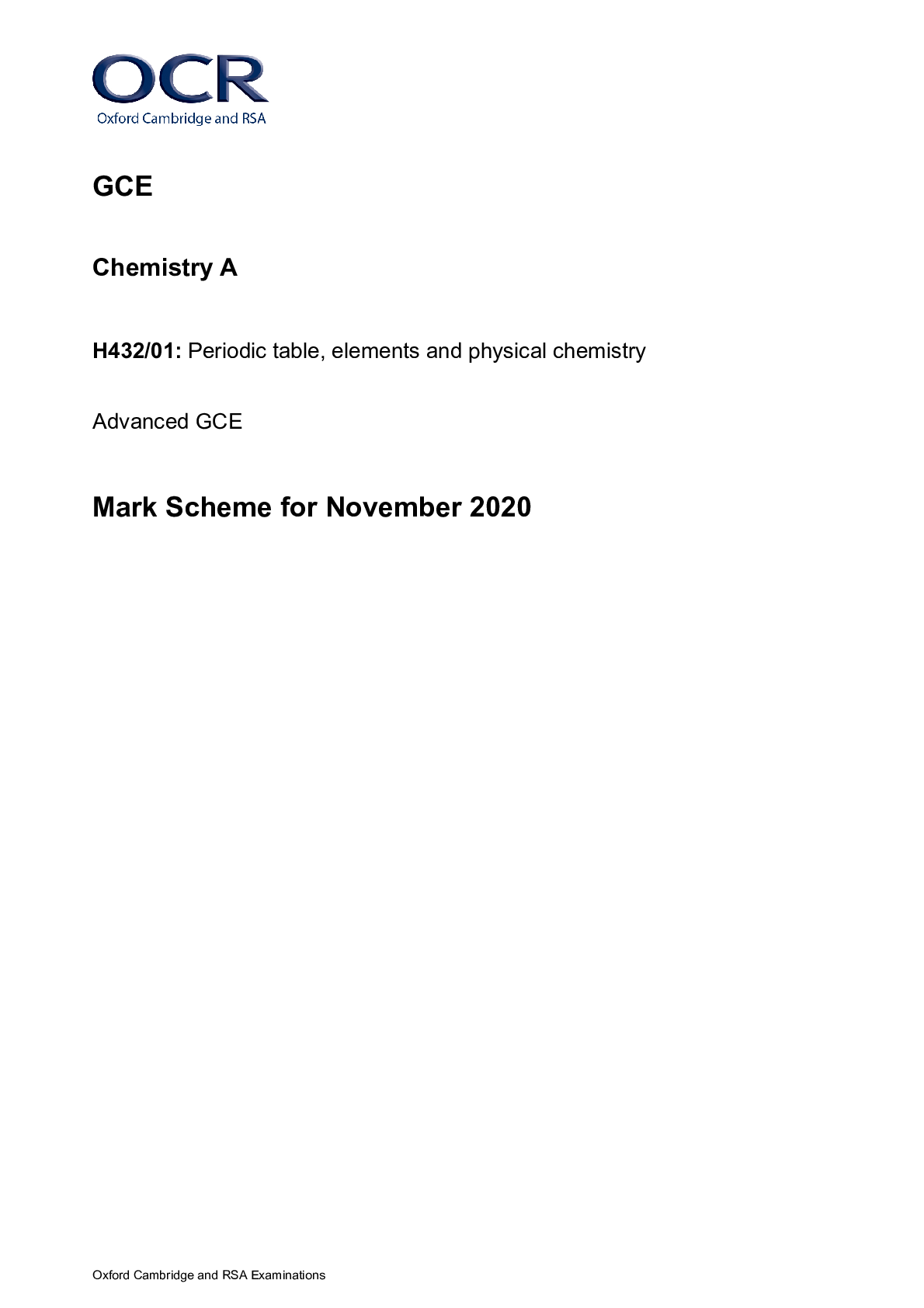


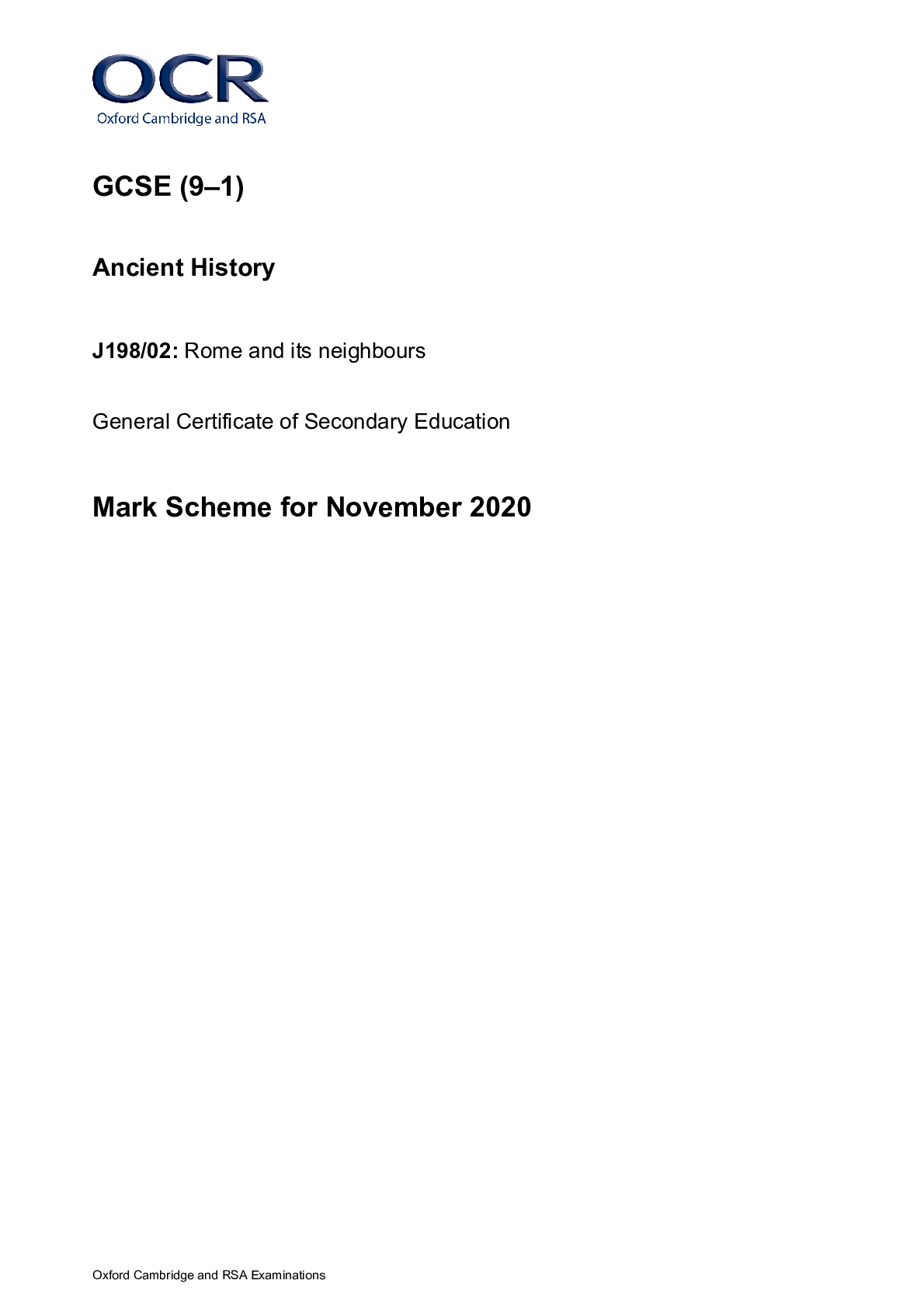



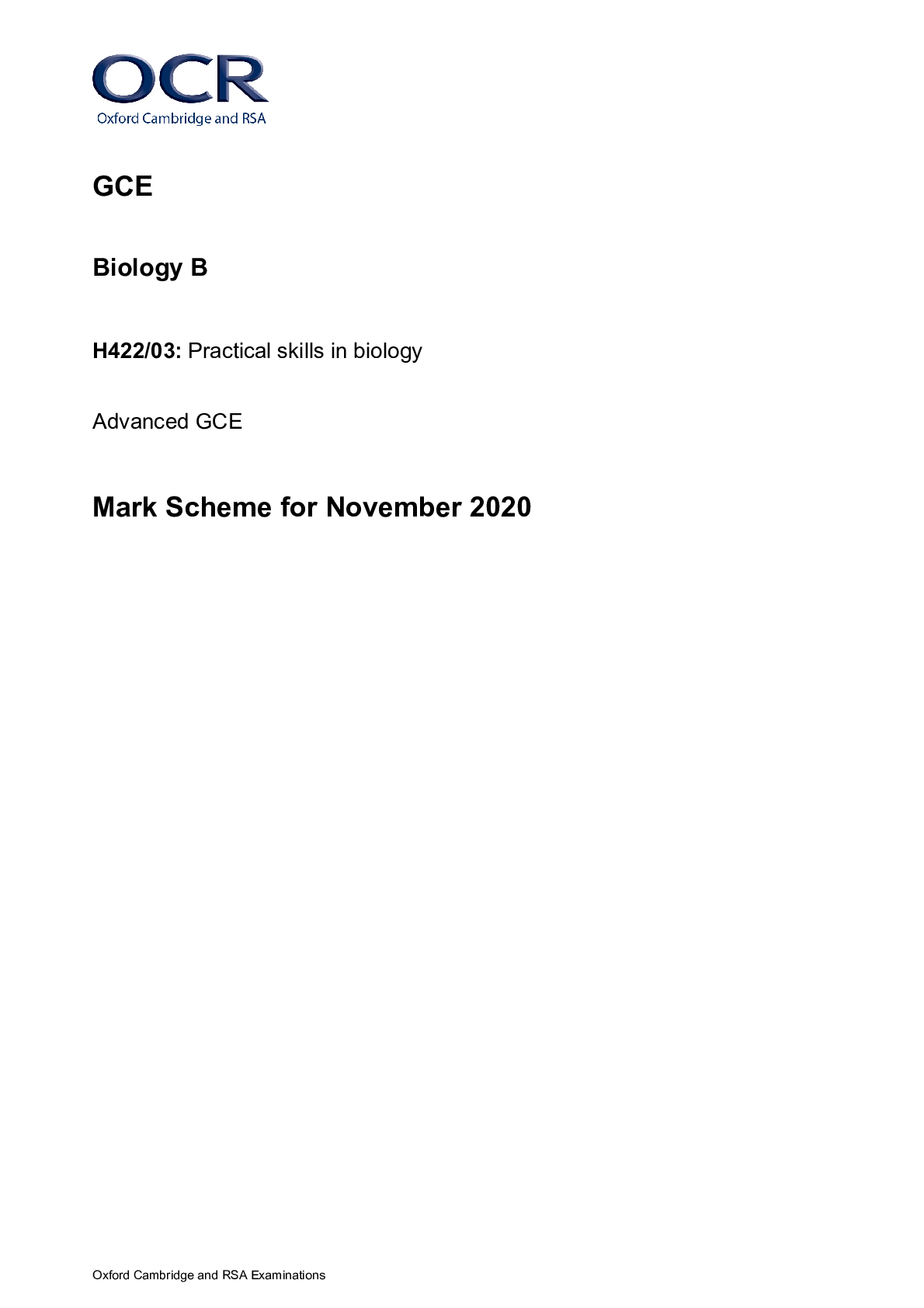
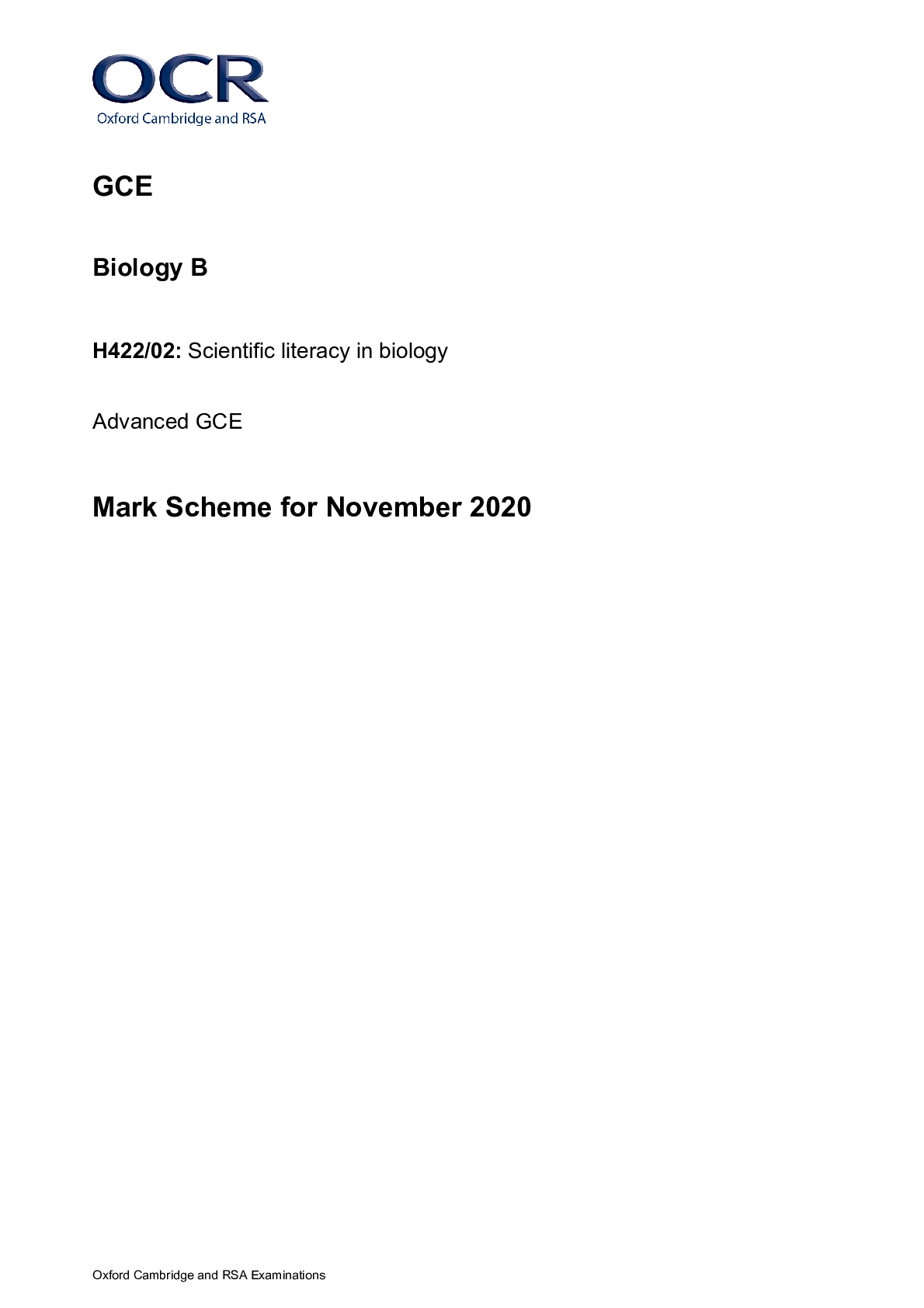
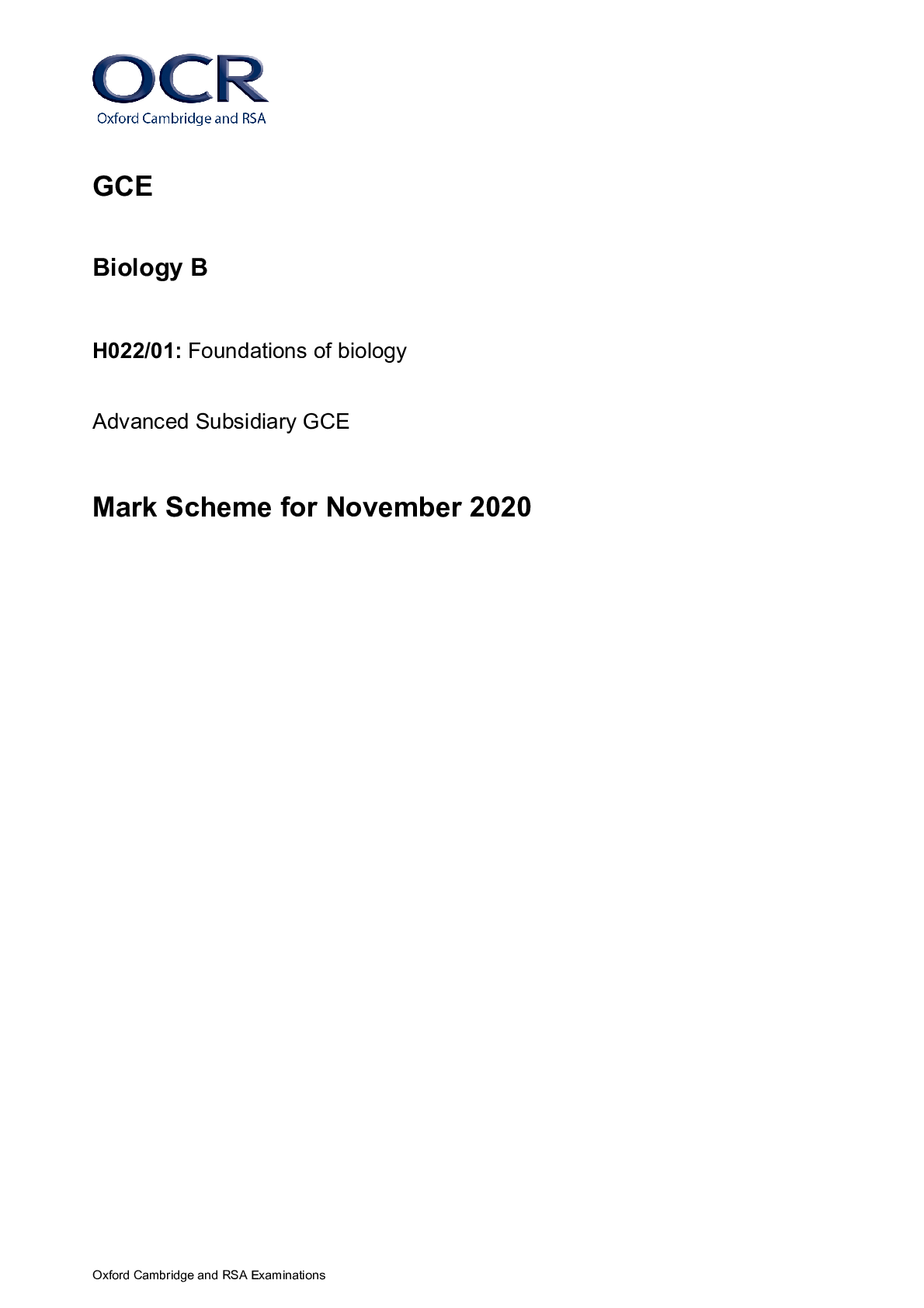

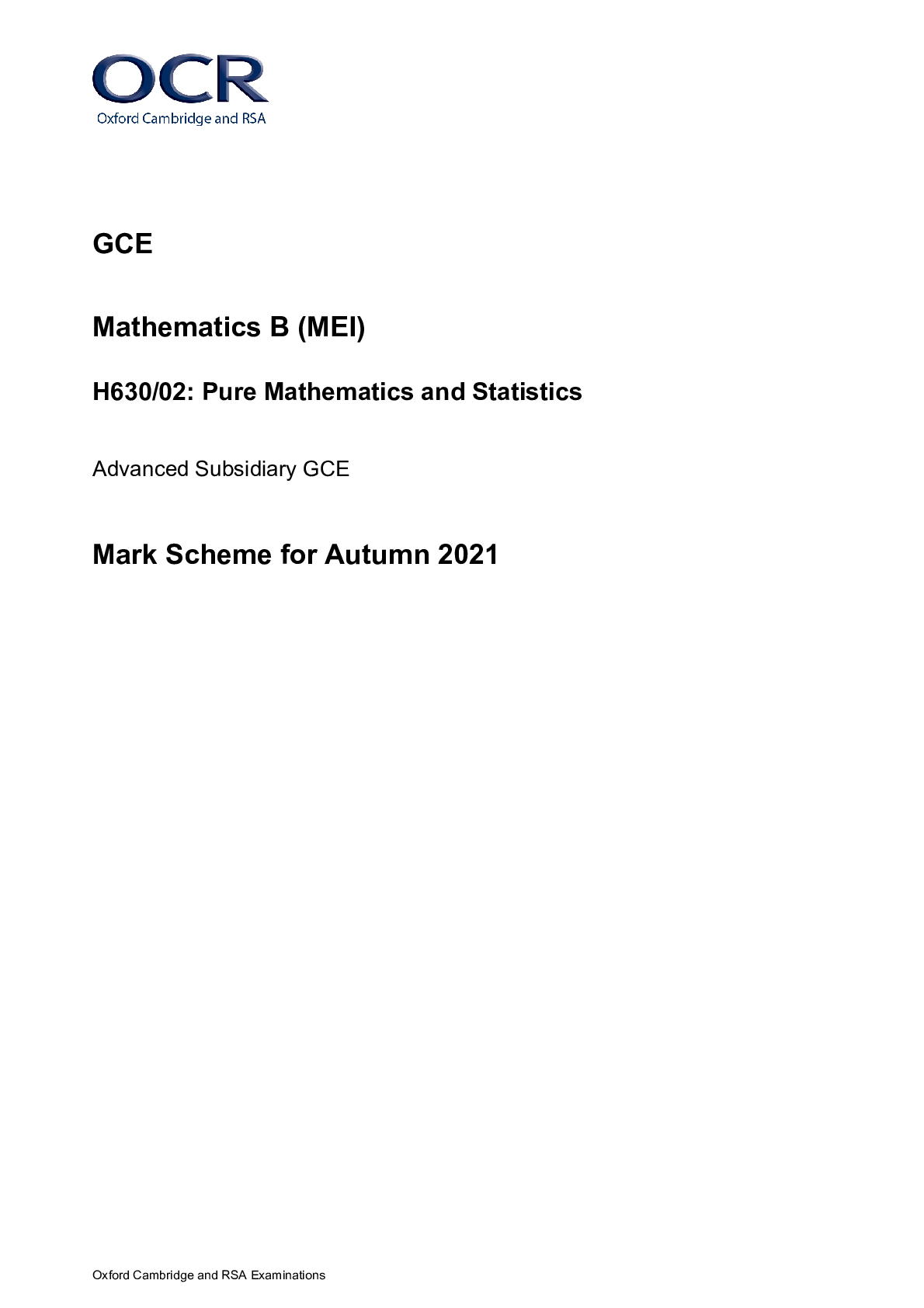


.png)
H630-02 Pure Mathematics and Statistics Advanced Subsidiary GCE Mark Scheme for Autumn 2021.png)




